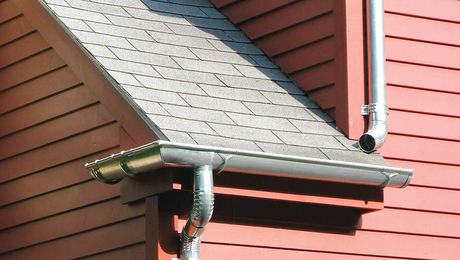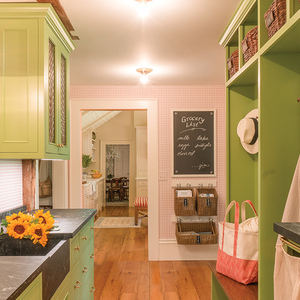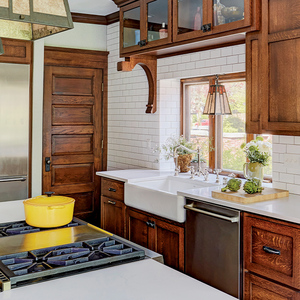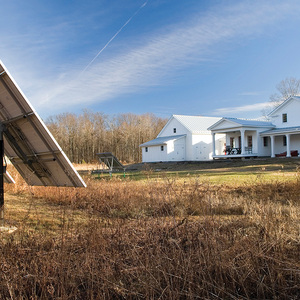During a search on flooring, I found some posts on water-lines to refrigerators that made think I’d better ask you guys: What’s the best (least likely to leak) way to hook a water line up to an ice-making refrigerator? We just bought a Whirlpool side-by-side, barely used, and it has a plastic line.
forestgirl — you can take the girl out of the forest, but you can’t take the forest out of the girl 😉




















Replies
Best way? Fill the ice trays in the sink.
The hoses that have stainless steel braiding on the outside. Where I live the well water seems to eat copper and plastic seems to scare a lot of people. The braided ones still have some sort of plastic or rubber inside but are pretty much burst proof (did not say leak proof) and protected to some degree.
"Where I live the well water seems to eat copper...." We're on a well, and we have old iron pipes -- makes the water smell funny, until it's run long enough to get past the stuff that's been sitting in the pipes. Brings me to the idea that I'd also like to put a great filter on the main line coming to the house. Next spring, I guess. Doesn't seem to bother our copper though.
"Plastic seems to scare a lot of people." Smart people probably. I no longer use plastic in the microwave, ever. Probably won't worry about any plastic in the 'fridge water line though.
I like the idea of using a braided line, thanks!forestgirl -- you can take the girl out of the forest, but you can't take the forest out of the girl ;-)
The story that keeps circulating about the dangers of using plastic in the microwave has been shown to be false. Check Snopes.com
http://www.snopes.com/medical/toxins/cookplastic.asp
Just FYI.
Edited 11/7/2006 2:37 pm ET by Terry
I know about that, I should have been more clear, the folks I am talking about are non-believers in plastic water lines including everything except PEX. I am not one of them. A lot of folks fear splitting, holes, degradation over time, etc. I have never heard any concerns voiced over health issues.
Copper has been around for a long time and are pretty well proven except for areas with high acid content and some very random quality issues. Many worry about whether current products will end up with problems like the stuff they put in trailers and in high rises where getting high enough pressure for upper floors blowing connectors down low. Followed by many lawsuits.
My icemakers are fed by plastic and I usually use cpvc for supply. Am thinking about tooling up for PEX though. I do not do all that much plumbing, usually extending or replacing existing.
I am a regular on snopes and enjoy sending the "you should read this" snopes referral.
Bob
Edited 11/8/2006 1:54 pm ET by rasconc
I should have been more clear myself. I was referring to your comment buried in the middle of the line, ""Plastic seems to scare a lot of people." Smart people probably. I no longer use plastic in the microwave, ever. Probably won't worry about any plastic in the 'fridge water line though. (emphasis added)." The article I posted at Snopes.com refers to the non-validity of the claim that cooking with plastic containers or plastic wrap in the microwave is unsafe.
Unfortunately, then you get folks like my fiance, who think it's OK to put any old kind of plastic in the microwave. While it's true that you can put some kinds of plastic in there with no problem, it's also true that other kinds melt, or soften even just a little, and then proceed to leak various kinds of unpleasant chemicals -- many of which smell and taste bad, too, I might add. OK, not specifically dioxin, and not specifically carcinogens. But still.Rebeccah
Ah, but the stuff that leaks out is the preservatives and stabilizers -- gotta be good for you!
People never lie so much as before an election, during a war, or after a hunt. --Otto von Bismarck
"preservatives and stabilizers -"I could certainly use more of both of those.
I knew what you were talking about, I have sent that very same Snopes rebutal to several who load my inbox with the latest "Oh ****, oh dear fear of the day".
I figured since we were in BT rather than CooksTalk everyone would know what plastics I was talking about (;-).
Edited 11/8/2006 8:38 pm ET by rasconc
Forestgirl, this is easier than you think. Usually you can go under the sink and replace the cold water angle valve with a "two way" (two separate handles) valve and a compression fitting. Then you just run the plastic line through the cabinets and get as close as you can to the fridge. From there, think like a mouse and run it along the wall where it will least be seen.
Alternately you could go down under the floor, but watch out for utilities when drilling.
The plastic line will do fine as long as it's well attatched and not kinked. Just be sure to leave it a comfortable working length so the fridge can be pulled out, and don't use the first batch of ice in any drinks.
The biggest danger with the plastic line (or any line, for that matter) is that it will get bumped, kinked, or abraded by the fridge, as it's moved around or vibrates during operation. The ideal installation would be to have a cold water valve installed in a wall niche behind the fridge, with a short run of braded line from there to the fridge itself. But it seems to be exceedingly rare to have the line pre-installed this way.
People never lie so much as before an election, during a war, or after a hunt. --Otto von Bismarck
When I first saw those boxes for frig connection I thought that they where a neet idea.But then I realized that the shutoff was behind the refigerator. I think that where practical a shut off under the sink or in the basement is better.
You've got to have enough slack in the connecting line to get the fridge out and disconnect the line, so it's no problem to reach the shutoff.
People never lie so much as before an election, during a war, or after a hunt. --Otto von Bismarck
Yes, but there are a number of people that are unable to move the refigerator or think that they are unable to move it and won't.
If they're not going to move the fridge, they don't need to operate the shutoff (assuming that they don't have to shut off the water to change the filter).
People never lie so much as before an election, during a war, or after a hunt. --Otto von Bismarck
Because of the heavy built-in refrigerator in my kitchen, I put the shut-off valve in a plastic wall box -- but I offset it a couple of feet so that it will be accessible from the cabinet beside the refrigerator. I ran 1/4" copper tubing from the valve horizontally through the wall and out behind the refrigerator, and I plan to use braided hose to connect the 1/4" tubing to the fridge. I guess there is still a possibility for that connection to leak, though. If I could find a braided hose long enough I would just use that all the way back to the valve.
I've bought/used some that were 10 feet long, braided with a fittings on each to fit onto a compression fitting.
TFB (Bill)
Probably depends on the age and location of the house. We have those valve boxes behind the fridges in both our 1980's Reseda houses. I put good quality ball valves in there, because you have to roll the fridge out and replace the in-line water filter every six months or so.
-- J.S.
I've got a 1/4" soft copper supply line feeding my refridg. Originally, before we bought the house, it fed an ice maker only. A couple of years ago, we bought a side-by-side, with ice dispenser on one side, water dispenser next to it. The water dispenser worked ok for a few years -- slow, but adequate. But now it is not much more than a dribble -- takes about 20 seconds to fill a 12 oz glass. Any suggestions on what might be wrong, and what I could do to fix it?********************************************************
"It is what we learn after we think we know it all, that counts."
John Wooden 1910-
If you don't have a clogged filter in the frig or under the sink then I would expect that you have a bad saddle valve.Some of the had a steal tip that pierces into the copper line. That will corrode and clog up.
Could also be limed up.
People never lie so much as before an election, during a war, or after a hunt. --Otto von Bismarck
No saddle valve -- teed off 1/2" supply line with ball valve (in the basement), then on to the 1/4" soft copper (thru the floor to the fridg). Would be easy enough to replace the whole set-up. Are ice and water dispensers always supplied with 1/4"?Thanks for your advice.********************************************************
"It is what we learn after we think we know it all, that counts."
John Wooden 1910-
In most cases yes“It so happens that everything that is stupid is not unconstitutional.” —Supreme Court Justice Antonin Scalia
Look for a screen at the connection to the solenoid valve(s) on the refigerator.
I'll take it apart at the valve (in the basement)and at the refrid -- looking for the screen, and see if there is any glunk. If I don't find anything, I'm going to call the mfg (Kitchen Aid), since this unit is only about 3 mos old, and it should still be under warranty. Thanks again.********************************************************
"It is what we learn after we think we know it all, that counts."
John Wooden 1910-
"From there, think like a mouse and run it along the wall where it will least be seen." Funny you should mention mice. The people who originally put in the water line ran it underneath the house from the bathroom (sheesh) and up through the floor through a big hole. Might as well have put a sign on it "Climb here for entrance to house." ROFL!
When we re-do the cabinets next year, I'll take your advice and run a line from the kitchen sink. For right now, Nick (hubby) put a little turn-off valve right in the line where it comes out of the floor. Cute little thing (I'm easily amused).forestgirl -- you can take the girl out of the forest, but you can't take the forest out of the girl ;-)
If I'm thinking like a mouse, I'm thinking of chewing on that plastic line just to see what happens.
they sell ice maker boxes that you run 1/2 line to and it sits inside the wall is one way but no matter how you do it dont forget the hammer aresster
The hammer arrester should be unnecessary. Not enough flow to cause hammer in a properly installed plumbing system.
People never lie so much as before an election, during a war, or after a hunt. --Otto von Bismarck
i dont think it has to do to the amount of flow ,but in the quickness that it stops the water flow
It's the rate of change, and the rate is lower if the volume is lower to begin with.
People never lie so much as before an election, during a war, or after a hunt. --Otto von Bismarck
should be unnecessary. Not enough flow to cause hammer
<g>, you've not heard my ice maker cycle then <g>
That's the fridge, though, not really the water line. I still like to plumbe an arrestor in if a ref'r box goes in the wall--it's what, a couple bucks against a call back?Occupational hazard of my occupation not being around (sorry Bubba)
Plastic water lines to feed ice makers should be banned. I've dealt with ruined ceilings in the basement here in MA and upset people below on the 62nd floor as well as ruined rugs and flooring in NY. I did use the valve box in our new home and think it's pretty slick. Saves you from having to go to the cellar to shut off the feed line on the manifold. Not that it's a big walk, sometimes I'm just lazy.
Is this for an "in-the-door" ice maker or an ice maker in the freezer box?
If in the freezer box, just don't bother to hook it up. They just make ice cubes, but this the frost free freeze and teh freeze adn thaw cycle you end up with a solid block of ice and need to throw the block out every few days. What a stupid idea. What a waste.
We installed a fancy armored line to the rear of our refrigerator. It never leaked. But the cheap, push-on nylon fitting GE put at the bottom of their door did let go one day, and before we caught it, it had leaked a good sized puddle. If we had been away on vacation, it could have been quite a mess, but fortunately there was no major damage.
I decided to just disconnect the water, forget the door water dispenser, and fill the icemaker bin with store-bought cubes. We don't have water in the door anymore, but I'd rather buy a couple hundred $2 bags of cubes than face a $10K repair bill.
When we got our last fridge we intentionally avoided the icemaker, even though that limited our choices a fair amount. In addition to the leak issues, icemakers are the most unreliable part of a fridge.
People never lie so much as before an election, during a war, or after a hunt. --Otto von Bismarck
or
http://www.firstdetection.com/flood_stop/
I think the main thing to do is NOT use a saddle valve that pierces the pipe. I had the plumber put in regular sweat on valves for the ice maker and for the humidifiers on the furnaces.
Coil enough slack behind the fridge to allow the fridge to pull out.
I've heard, but cannot confirm, that some areas are banning the piercing saddle valves.
Most stops have a compression fitting going to the riser, I have seen a T that can be attached to that and run the line off to the icemaker and continue on up to riser. Have found a three compression stop that can be put in line with the pex risers also, a real easy fix. Have also seen a stop that had additional outlet for icemaker. I do like the idea of being able to turn off water without moving fridge.